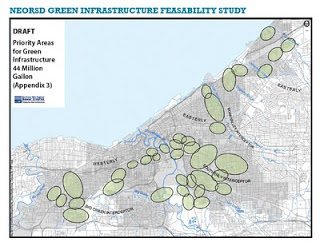
GREEN: 1,000 acres, 30+ green projects to be identified by year’s end
Posted by Jared Shepherd
- 4787 Views
- September 23rd, 2011
- in Miscellaneous
- No Comments
By December 31, an already environmentally focused Project Clean Lake will be eco-friendlier.
The Northeast Ohio Regional Sewer District is nearing completion of its Green Infrastructure Feasibility Study, a requirement of its recent consent decree with the Federal government, that will identify priority areas to further reduce sewage overflows using less-traditional Green Infrastructure projects.
Known as Project Clean Lake, the combined sewer overflow (CSO) control consent decree includes opportunities for green infrastructure negotiated by the District. The consent decree requires the District to plan, design, and construct at least $42 million in green infrastructure capable of capturing 44 million gallons or more annually. The District must meet this requirement by 2019. When the study is complete in December, the District will present its plan to the US Environmental Protection Agency. | UPDATE 2011 12/28 Download the full report
In 2010, the Sewer District began the study to identify and prioritize opportunities for green infrastructure in the District’s combined sewer area. Currently, more than 13,000 acres in Cleveland have been identified as having potential to meet the Sewer District’s consent-decree-related green-infrastructure objectives (these areas are identified in the map above). By the end of this month, the District will have narrowed its focus to about 1,000 acres and 30 priority-project areas that will deliver the largest CSO volume reduction. The feasibility study is expected to be complete in mid-December.
“This program is a huge opportunity for Northeast Ohio to address two challenges,” said Kellie Rotunno, Director of Engineering and Construction, “one is CSO, and the other is vacant land.” She said Green Infrastructure can merge both problems “into a wholistic environmental solution with community benefits.”
The US EPA Region V named the Sewer District as a Green Infrastructure Partner last spring. “Other communities across the country will be looking to Cleveland to learn from our experience as we implement our Green Infrastructure Plan,” Rotunno said. She added there will be technical, logistical and political challenges ahead, “but the end result will be something that our region can be proud of.”
In addition to the CSO program, the Green Infrastructure projects present other opportunities for our region. “Our regional stormwater management program can learn from the projects and success we can realize in the green-infrastructure work of our consent decree,” said Watershed Programs Manager Kyle Dreyfuss-Wells. The District’s green infrastructure program will use stormwater control measures to manage stormwater before it enters the combined system; the District’s stormwater program will use stormwater control measures to target regional flooding and erosion problems.
Green infrastructure projects have the potential of benefiting their surrounding neighborhoods as well. In areas where the City of Cleveland is looking for permanent uses of vacant land, green infrastructure offers the potential to convert unused or vacant properties with impervious surface to “managed greenspace” and other uses supportive of redevelopment, Dreyfuss-Wells explained. “We’re working very closely with the City of Cleveland as we move forward with this plan to ensure we support City initiatives.”


